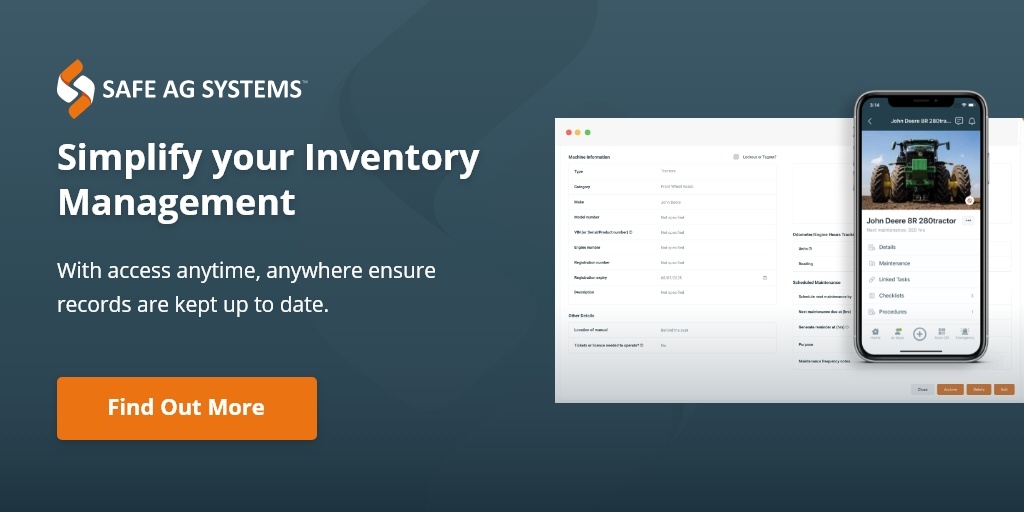Around the globe, the common theme is that Agriculture ranks as one of the most dangerous industries. In 2019, the U.S. agricultural industry employed approximately 2,112,626 full time workers. Also in 2019, 410 of those farmers and farm workers died as a result of a work-related injury - resulting in a fatality rate of 19.4 deaths per 100,000 workers.
In 1970 the Occupational Safety and Health Act of 1970 was introduced. The OSH Act 1970 established that employers employing one or more workers have a legal responsibility to ensure their employees have a safe work environment. This means a farmer or rancher in the U.S. must incorporate a safety and health program that aligns and is compliant with the Occupational Safety and Health Administration (OSHA) rules, regulations and standards.
OSHA on the Farm
The aim of the OSH Act of 1970 is, “To assure safe and healthful working conditions for working men and women; by authorizing enforcement of the standards developed under the Act; by assisting and encouraging the States in their efforts to assure safe and healthful working conditions; by providing for research, information, education, and training in the field of occupational safety and health; and for other purposes.”
The objective of the OHS Act or OSHA is to reduce the number of occupational safety and health hazards in the workplace, reducing injuries and fatalities, lost production, wage loss, medical expenses, and disability compensation payments.
Dangers of thinking the OSH Act doesn’t apply to agricultural operations.
Whilst many believe agricultural employers with less than 10 employees are exempt from following OSHA rules and regulations, that is not the case. This does not mean that farmers with less than 10 employees are not required to comply with the OHS Act.
An amendment in 1977 saw the OSHA restrict the use of funds to prescribe, issue, administer or enforce agricultural regulations for farming employers of 10 or less people. This restriction may reduce the enforcement of OSHA rules and regulations; however, it does not stop them being used in a lawsuit against an agricultural employer. Agricultural operations should always strive to comply with the Occupational Safety and Health Act, standards, rules and regulations no matter how many workers they employ.
Generally, there is confusion about who is defined as an employee or who counts as an employee since many farmers and ranchers utilise family members to assist during peak times. The OSHA notes immediate family members are excluded from the count; however some employers make an incorrect assumption and do not include aunts, uncles, cousins or grandchildren, therefore breach the threshold.
What duties do farm employers have under OSHA?
Under the OSHA, agricultural operations, farmers and ranchers have three general responsibilities for the safety and health of their employees:
-
To comply with the agricultural safety standards
-
To comply with the general duty clause
-
To comply with record keeping and other reporting responsibilities, such as reporting accidents, posting of a citation, etc.
What are the employee’s responsibilities?
As an employee, they also have rights and responsibilities to contribute to farm safety. The aim of the OSH Act is that you go home happy and healthy at the end of each day. An employee’s duty is to comply with safety and health standards, regulations and rules set by your employer that promote a safe workplace. Disciplinary action is advised for non-compliance.
What are the OSHA standards for agriculture?
The OSH Act covers businesses within the private sector, both the employers and their employees, across 50 states. There are two sets of standards applicable to agricultural operations, General Industry Standards (29 CFR 1910) and those specific to farm safety and Agriculture (29 CFR 1928).
General Industry (29 CFR 1910)
1910 Subpart H - Hazardous Materials
1910 Subpart J - General Environmental Controls
1910 Subpart R - Special Industries
1910 Subpart Z - Toxic and Hazardous Substances
Agriculture (29 CFR 1928)
1928 Subpart A – General
1928 Subpart B - Applicability of Standards
1928 Subpart C - Roll-Over Protective Structures
1928 Subpart D - Safety for Agricultural Equipment
1928 Subpart I - General Environmental Controls
1928 Subpart M - Occupational Health
What is the General Duty Clause?
Agricultural employees/workers are protected from the General Duty Clause of the OSH Act. This clause covers all industries and determines that an employer must “furnish to each of his employees’ employment and a place of employment which are free from recognized hazards that are causing or are likely to cause death or serious physical harm to his employees”. Employers must comply with occupational safety and health standards declared under the OHS Act whilst employees are required to comply with standards, rules, regulations, and directives given to them that are applicable to their own actions and conduct.
OSHA and recordkeeping
Under the OSH Act agricultural operations with 10 or more employees are required to keep records regarding work-related injuries and illness. Injuries that only require first aid are exempt from being recorded. The OSHA utilise these records to identify the safety of a workplace as well as understand, reduce, and eliminate industry hazards. All records must be kept for a minimum of five years. Each year from February to April, farmers and ranchers are required to provide a summary of the injuries and illnesses recorded the previous year. This summary is completed via an OSHA form 300, Injury & Illness Recordkeeping Forms.
Disclaimer: Content on this website may be of relevance to users outside of United States, but content links and examples are specific to the U.S. Please check with your local authority for your country and industry requirements.






.jpg?width=1024&height=512&name=Discovery%20Call%20-%20CTA%20(1).jpg)





